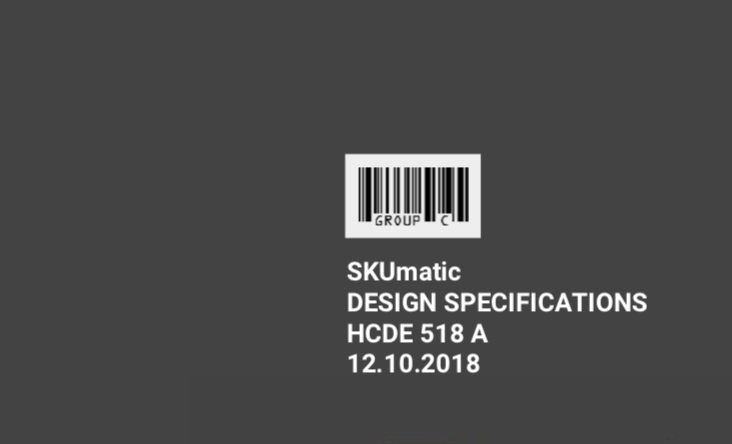


SKU-matic Project Overview
SKUmatic is designed to alleviate the user pain points identified from our research with local shopkeepers and retail associates
SKU-matic Project Overview
SKUmatic is designed to alleviate the user pain points identified from our research with local shopkeepers and retail associates
TITLE
SKU-matic: Inventory Tool for Specialty Retail
Background
Having inventory kept up-to-date is crucial for the success of a retail business. However, businesses must juggle many variables – customer holds, damages, and items used for display purposes – that make tracking inventory difficult to manage. The current market contains several tools promising to deliver inventory management solutions, however such tools are costly and contain a feature-set with a steep learning curve.
PROJECT GOAL
Our solution aims to provide a low barrier to entry with a pared-down feature set that focuses on delivering value quickly so retailers can take control of their inventories. Our goal is to improve the users’ inventory management experience so that they can focus their time and efforts on customer interactions and growing their business.
Graduate SCHOOL TEAM Project
Team Project in Human Centered Design and Engineering (HCDE) program to practice a full cycle of UCD research, design, prototype and testing.
Kevin Philbin
My ROLEs
Qualitative researcher
Semi-strutured interviews
Digital Prototyper
Sketch and lo-fi prototyping
DESIGN Question
How might we help niche retailers reduce the tedium and manual labor involved in managing the item life cycle so that they can focus on 1:1 customer interactions to grow their business?
We targeted specialty retailers like clothing, books, wine and bicycles.
We conducted seven semi-structured interviews with store owners, managers, retail workers and buyers.
Research Participants

Methods and Artifacts
Methods and Artifacts
RESEARCH Questions
How are current inventory management systems meeting or falling short on retailers’ needs?
What role does inventory management play in day-to-day retail operations?
In what ways can inventory management affect customer experience?
To what extent might inventory management play in the overall success of a retail business?
ResEARCH Methods
Contextual Inquiry
We chose contextual inquiry so that we could see the physical artifacts of inventory management, shadow the actual processes, and experience the environment and context of these processes.
Location-based materials and other environmental factors are very important for inventory management, so the opportunity to visit the site was important for our research.
1:1 semi-structured interviews
The weakness of contextual inquiry is that it limits our ability to probe on motivations for tasks, stakeholder values, and other activities which we are not present for.
For that reason, we complimented our contextual inquiry with 1:1 semi-structured interviews. These interviews could be scheduled more flexibly to accommodate our participants in this constrained time frame.
Additionally, interviews enabled us to ask targeted, open-ended questions, and to extract valuable findings to enrich our understanding of our users and the domain space.
SALIENT QUALITIES OF USERS
Interview Focus
ReSEArch Painpoints
Reliance on manual data entry
Reordering stock is major pain due to strategy involved (do we phase out a certain item once it’s sold, is surge purchasing a passing trend?) and manual process of receiving restocking once arrived.
Items are shipped in multiple boxes, making it difficult to “receive” shipments all in one go.
Multiple doc types are generated between systems and do not “talk” to each other
Diversity of inventory item types = difficult to create a taxonomy that works for all item attributes
Different vendors provide different UPC codes, making it difficult to unify
Knowing the dollar value of inventory is important for financial bookkeeping, restocking and growth
Minimize the amount of tedious, manual data entry
Be able to read/make immediate use of diverse document types that accompany vendor stock shipments
Allow for customization for a wide variety of item types
Consider playing to the spatial layout of the store
Be self-service focused to reduce the amount of overhead support costs involved with onboarding
Make inventory management NOT intimidating
Give users visibility of the $ value of their inventory
Help users understand what is in stock and what needs reordering
DESIGN REQUIREMENTS
ReSearch ARTIFACTS
Early Stage Mind Map
Competitive Analysis
USER RESEARCH REPORT
DESIGN ARTifacts
Sketches
PROTOType Evaluation
PRototype Walkthrough
FINAL PRESENTATION DECK
DEsign Specifications
DEMO PROTOTYPE
This project confirmed my desire to work with teams to do research and design work. I gained a sense of how extensive the process was to research, design, prototype and evaluate, while getting to wade into those waters with an experienced team.
There appears a tension between allowing an output to morph as user needs are better understood through testing, and the pragmatic urge to have something built.
It occurs that iteration can create a feedback loop that nothing is ever ready to ship, but through one of our group core values of “build something bit-sized” we were able to resist project creep and focus on a practical build.
This prototype was my first experience building interactivity in Axure.
Learnings
My personal reflection of the experience of the project and personal design principles that emerged from the group project. Group dynamics was a huge learning for me.










